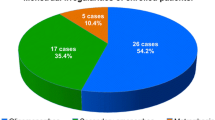Abstract
Purpose
Spironolactone (SP) is an effective treatment for polycystic ovary syndrome (PCOS), but it is often associated with menstrual abnormalities whose mechanism is still under investigation. In this study, we investigated the serum sex steroids and endometrial thickness in 30 PCOS patients, before and after one-month 100 mg SP treatment.
Methods
Serum FSH, LH, estradiol, progesterone and endometrial thickness were evaluated at the 14th and 16th day of the menstrual cycle, before and during short-term SP treatment. According to the presence (15 cases) or absence (15 cases) of menstrual bleeding at the 14th day during SP, the patients were divided into two groups, which were then compared using a two-tailed Student’s t test.
Results
Serum estradiol and endometrial thickness were lower than pretreatment at both determinations in all patients, but patients with bleeding had significantly lower estradiol values than non-bleeding ones, both before and after therapy. Endometrial thickness was significantly lower in the bleeding group compared with non-bleeding group only at the 16th day of the cycle. These differences were significant, even though the values of estradiol and endometrial thickness remained in the normal range.
Conclusions
SP therapy can reduce the values of estradiol and the endometrial thickness in patients with PCOS compared with pretreatment, but PCOS patients with bleeding had pretreatment estradiol values lower than the patients who did not complain of this side effect. Intermenstrual abnormalities may represent the low estrogen impregnation of endometrium due to SP, whose mechanism is complex, involving several factors, such as the effects of some metabolites of SP on estradiol and progesterone production, on their receptors, and the individual metabolism of SP in vivo.


Similar content being viewed by others
References
Armanini D, Karbowiak I, Goi A, Mantero F, Funder JW (1985) In-vivo metabolites of spironolactone and potassium canrenoate: determination of potential anti-androgenic activity by a mouse kidney cytosol receptor assay. Clin Endocrinol 23:341–347
Shapiro G, Evron S (1980) A novel use of spironolactone: treatment of hirsutism. J Clin Endocrinol Metabol 51:429–432
Sirmans SM, Pate KA (2013) Epidemiology, diagnosis, and management of polycystic ovary syndrome. Clin Epidemiol 6:1–13
Spritzer PM, Lisboa KO, Mattiello S, Lhullier F (2000) Spironolactone as a single agent for long-term therapy of hirsute patients. Clin Endocrinol 52:587–594
Corvol P, Michaud A, Menard J, Freifeld M, Mahoudeau J (1975) Antiandrogenic effect of spironolactones: mechanism of action. Endocrinology 97:52–58
Stripp B, Taylor AA, Bartter FC, Gillette JR, Loriaux DL, Easley R, Menard RH (1975) Effect of Spironolactone on sex hormones in man. J Clin Endocrinol Metabol 41:777–781
Baba S, Murai M, Jitsukawa S, Hata M, Tazaki H (1978) Antiandrogenic effects of spironolactone: hormonal and ultrastructural studies in dogs and men. J Urol 119:375–380
Messina M, Manieri C, Biffignandi P, Massucchetti C, Novi RF, Molinatti GM (1983) Antiandrogenic properties of spironolactone. Clinical trial in the management of female hirsutism. J Endocrinol Investig 6:23–27
Armanini D, Castello R, Scaroni C, Bonanni G, Faccini G, Pellati D, Bertoldo A, Fiore C, Moghetti P (2007) Treatment of polycystic ovary syndrome with spironolactone plus licorice. Eur J Obstet Gynecol Reprod Biol 131:61–67
Ehrmann DA (2005) Polycystic ovary syndrome. N Engl J Med 352:1223–1226
Armanini D, Bordin L, Donà G, Sabbadin C, Bakdounes L, Ragazzi E, Giorgino FL, Fiore C (2012) Polycystic ovary syndrome: implications of measurement of plasma aldosterone, renin activity and progesterone. Steroids 77:655–658
Cascella T, Palomba S, Tauchmanovà L, Manguso F, Di Biase S, Labella D, Giallauria F, Vigorito C, Colao A, Lombardi G, Orio F (2006) Serum aldosterone concentration and cardiovascular risk in women with polycystic ovarian syndrome. J Clin Endocrinol Metabol 91:4395–4400
Helfer EL, Miller JL, Rose LI (1988) Side-effects of spironolactone therapy in the hirsute woman. J Clin Endocrinol Metabol 66:208–211
Smals AGH, Kloppenborg PWC, Hoefnagels WH, Drayer JIM, Benraad ThJ (1978) Pituitary and gonadal function in high-dose spironolactone-treated premenopausal women. Aldosterone antagonists in clinical medicine. Proceedings of the Searle symposium, Nice 303–307
Shane HP, Potts GO (1978) Oral progestational activity of spironolactone. J Clin Endocrinol Metabol 47:691–694
Fernandez MD, Carter GD, Palmer TN (1983) The interaction of canrenone with oestrogen and progesterone receptors in human uterine cytosol. Br J Clin Pharmacol 15:95–101
Sundar S, Dickinson PD (2012) Spironolactone, a possible selective androgen receptor modulator, should be used with caution in patients with metastatic carcinoma of the prostate. BMJ Case Reports. doi:10.1136/bcr.11.2011.5238
Levy J, Burshell A, Marbach M, Afflalo L, Glick SM (1980) Interaction of spironolactone with estradiol receptors in cytosol. J Endocrinol 84:371–379
Moghetti P, Castello R, Zamberlan N, Rossini M, Gatti D, Negri C, Tosi F, Muggeo M, Adami S (1999) Spironolactone, but not flutamide, administration prevents bone loss in hyperandrogenic women treated with gonadotropin-releasing hormone agonist. J Clin Endocrinol Metabol 84:1250–1254
Rotterdam ESHRE/ASRM-Sponsored PCOS Consensus Workshop Group (2004) Revised 2003 consensus on diagnostic criteria and long-term health risks related to polycystic ovary syndrome. Fertil Steril 81:19–25
Armanini D, Sabbadin C, Donà G, Clari G, Bordin L (2014) Aldosterone receptor blockers spironolactone and canrenone: two multivalent drugs. Expert Opin Pharmacother 15:909–912
Acknowledgments
We acknowledge Ms. Sophie Armanini for English revision. Dr. Marta Zermiani is actually working in Barcelona.
Author information
Authors and Affiliations
Corresponding author
Ethics declarations
Conflict of interest
The authors declare that they have no conflict of interest.
Ethical approval
All procedures performed in this study involving human participants were in accordance with the ethical standards of the institutional research committee and with the 1964 Helsinki declaration and its later amendments or comparable ethical standards.
Informed consent
Informed consent was obtained from all individual participants included in the study.
Rights and permissions
About this article
Cite this article
Sabbadin, C., Andrisani, A., Zermiani, M. et al. Spironolactone and intermenstrual bleeding in polycystic ovary syndrome with normal BMI. J Endocrinol Invest 39, 1015–1021 (2016). https://doi.org/10.1007/s40618-016-0466-0
Received:
Accepted:
Published:
Issue Date:
DOI: https://doi.org/10.1007/s40618-016-0466-0




